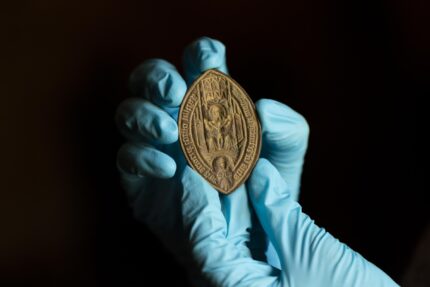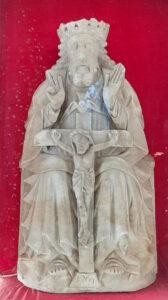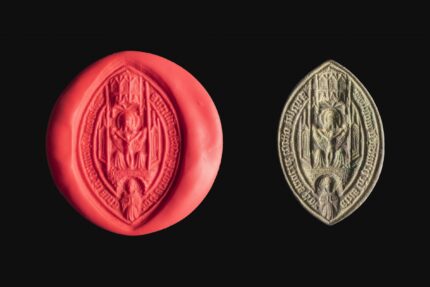 A seal matrix used to authenticate indulgences granted to penitents by the Priory at Mottisfont in Hampshire in the 15th century is going on display at Mottisfont Abbey, the stately home that is its direct descendant. The cast copper alloy almond-shaped die was discovered by a metal detectorist two miles from Mottisfont where a market stood in the Middle Ages, perhaps lost by a canon selling his priory’s repentance wares to sinners.
A seal matrix used to authenticate indulgences granted to penitents by the Priory at Mottisfont in Hampshire in the 15th century is going on display at Mottisfont Abbey, the stately home that is its direct descendant. The cast copper alloy almond-shaped die was discovered by a metal detectorist two miles from Mottisfont where a market stood in the Middle Ages, perhaps lost by a canon selling his priory’s repentance wares to sinners.
The seal features an enthroned God the Father, his hands raised in blessing, with the crucified Christ between his knees. A tiny, barely visible dove of the Holy Spirit is perched above Christ’s left shoulder. Beneath the representation of the Trinity is a stone arch with a cleric praying. The inscription around the oval reads ” sigillu officii prioris (p’or – etas) Cce trinitat’ de moteCfont,” meaning “seal of the prior of [the priory] of the Holy Trinity of Mottisfont.” It would have been stamped on hot wax and the impression affixed to the indulgence document.
 The iconography of the enthroned God with draped robes and a forked beard with Christ on the cross between his legs and the dove above the cross is known as a Throne of Mercy type. It is a characteristic representation of the Trinity in 15th century English art, particularly the alabaster statues and panels carved by artisans in Nottingham.
The iconography of the enthroned God with draped robes and a forked beard with Christ on the cross between his legs and the dove above the cross is known as a Throne of Mercy type. It is a characteristic representation of the Trinity in 15th century English art, particularly the alabaster statues and panels carved by artisans in Nottingham.
Mottisfont Abbey was founded in 1201 by William Briwere, an administrator and judiciary to four Plantagenet kings (Richard the Lionhearted appointed him as judiciary in charge of the kingdom when he went on the Third Crusade in 1189), as the Priory of the Holy Trinity. Owned and operated by Augustinian canons, it was famed for its sacred relic: a finger of John the Baptist. It became a popular stop for pilgrims on the way from Canterbury to Winchester and prospered from the pilgrim trade and from lavish donations made by local aristocrats to pray for their souls and the souls of their departed loved ones.
The Abbey was struck by the Black Death in 1348, and it struck hard. At least two priors and three of Mottisfont’s cellarers died from the bubonic plague and as a third of Europe died with them, the priory’s income front rents, mills, orchards, churches and markets took a massive hit. There were so few canons left that they had to import a new prior from Leicester in 1352.
 With its priestly ranks and revenues so drastically reduced, the priory was in danger of going under. Its patron, Henry of Lancaster, petitioned Pope Innocent VI for an indulgence to all who visited or donated to Mottisfont on Trinity Sunday (the first Sunday after Pentecost). Innocent approved and granted all the priory’s Trinity Sunday penitents for the next five years one year and 40 days off their time in Purgatory. He even went beyond Henry’s request, granting one year and 40 day indulgences for visitors to the priory church on the feasts of the Holy Trinity, the Holy Cross, St. Michael, and the Assumption and Nativity of Mary.
With its priestly ranks and revenues so drastically reduced, the priory was in danger of going under. Its patron, Henry of Lancaster, petitioned Pope Innocent VI for an indulgence to all who visited or donated to Mottisfont on Trinity Sunday (the first Sunday after Pentecost). Innocent approved and granted all the priory’s Trinity Sunday penitents for the next five years one year and 40 days off their time in Purgatory. He even went beyond Henry’s request, granting one year and 40 day indulgences for visitors to the priory church on the feasts of the Holy Trinity, the Holy Cross, St. Michael, and the Assumption and Nativity of Mary.
Things started looking up in the first decades of the 16th century. In a reorganization by Henry VII, the priory was reassigned as a subsidiary of Westminster Abbey and in 1521 landed a new patron, the wealthy wine merchant and sheriff of Southampton Henry Huttoft. The revival of Mottisfont’s fortunes came to a screeching halt in 1536 with the Dissolution of the Monasteries under Henry VIII. It managed to avoid the total destruction that swept away so many other monasteries by being sold off to William Sandys, the king’s Lord Chamberlain. Instead of demolishing it, he converted it into an elegant Tudor mansion.
Today Mottisfont Abbey, heavily modified in the 18th century, is an historic estate operated by the National Trust. The seal matrix was acquired by the National Trust and went on display at Mottisfont Abbey last Saturday.